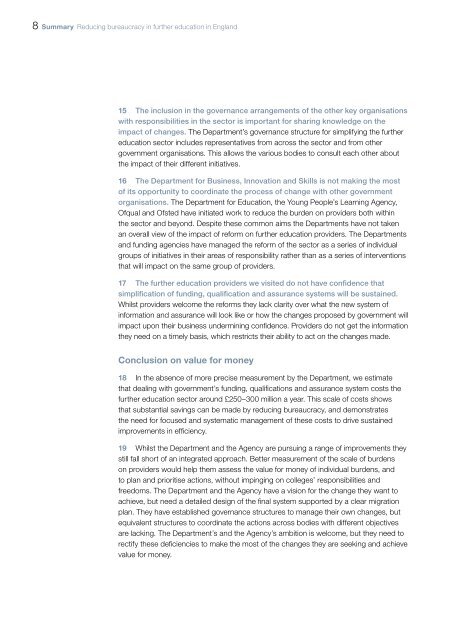Full report (pdf - 326KB) - National Audit Office
Full report (pdf - 326KB) - National Audit Office
Full report (pdf - 326KB) - National Audit Office
Create successful ePaper yourself
Turn your PDF publications into a flip-book with our unique Google optimized e-Paper software.
8 Summary Reducing bureaucracy in further education in England<br />
15 The inclusion in the governance arrangements of the other key organisations<br />
with responsibilities in the sector is important for sharing knowledge on the<br />
impact of changes. The Department’s governance structure for simplifying the further<br />
education sector includes representatives from across the sector and from other<br />
government organisations. This allows the various bodies to consult each other about<br />
the impact of their different initiatives.<br />
16 The Department for Business, Innovation and Skills is not making the most<br />
of its opportunity to coordinate the process of change with other government<br />
organisations. The Department for Education, the Young People’s Learning Agency,<br />
Ofqual and Ofsted have initiated work to reduce the burden on providers both within<br />
the sector and beyond. Despite these common aims the Departments have not taken<br />
an overall view of the impact of reform on further education providers. The Departments<br />
and funding agencies have managed the reform of the sector as a series of individual<br />
groups of initiatives in their areas of responsibility rather than as a series of interventions<br />
that will impact on the same group of providers.<br />
17 The further education providers we visited do not have confidence that<br />
simplification of funding, qualification and assurance systems will be sustained.<br />
Whilst providers welcome the reforms they lack clarity over what the new system of<br />
information and assurance will look like or how the changes proposed by government will<br />
impact upon their business undermining confidence. Providers do not get the information<br />
they need on a timely basis, which restricts their ability to act on the changes made.<br />
Conclusion on value for money<br />
18 In the absence of more precise measurement by the Department, we estimate<br />
that dealing with government’s funding, qualifications and assurance system costs the<br />
further education sector around £250–300 million a year. This scale of costs shows<br />
that substantial savings can be made by reducing bureaucracy, and demonstrates<br />
the need for focused and systematic management of these costs to drive sustained<br />
improvements in efficiency.<br />
19 Whilst the Department and the Agency are pursuing a range of improvements they<br />
still fall short of an integrated approach. Better measurement of the scale of burdens<br />
on providers would help them assess the value for money of individual burdens, and<br />
to plan and prioritise actions, without impinging on colleges’ responsibilities and<br />
freedoms. The Department and the Agency have a vision for the change they want to<br />
achieve, but need a detailed design of the final system supported by a clear migration<br />
plan. They have established governance structures to manage their own changes, but<br />
equivalent structures to coordinate the actions across bodies with different objectives<br />
are lacking. The Department’s and the Agency’s ambition is welcome, but they need to<br />
rectify these deficiencies to make the most of the changes they are seeking and achieve<br />
value for money.

















